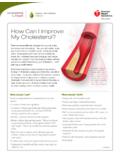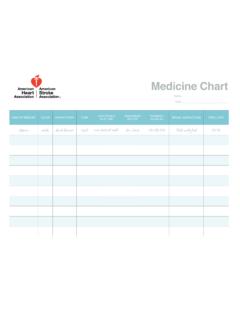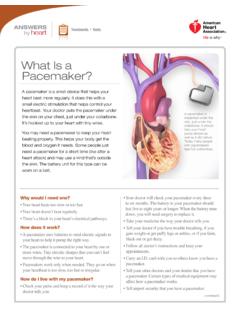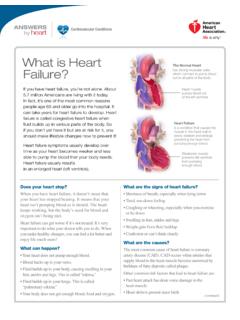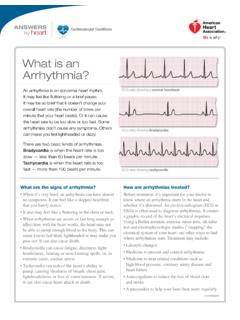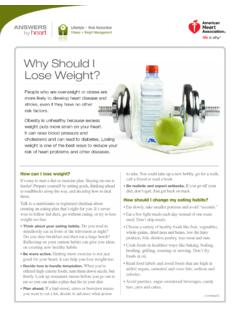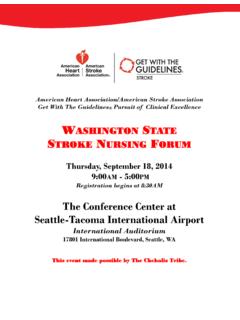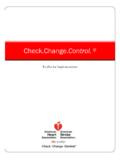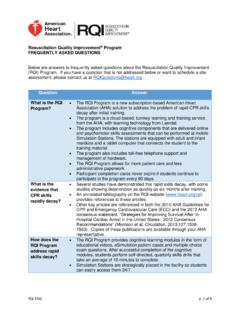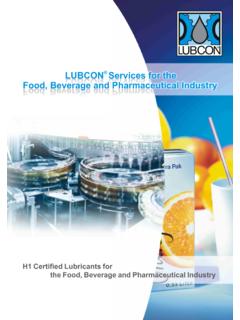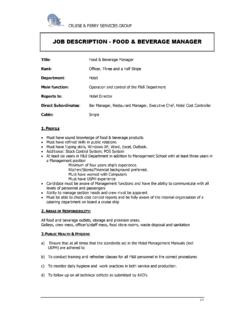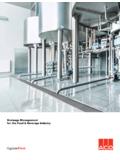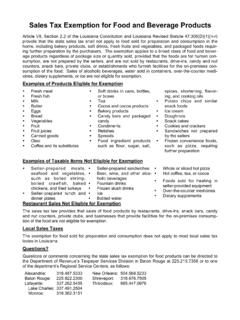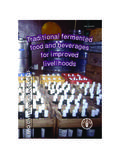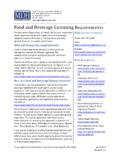Transcription of HEALTHY WORKPLACE food and beverage
1 food and beverageHEALTHY WORKPLACE Introduction ..3 AHA Mission, Goal and Guiding Values ..3 Background ..4 Terminology ..5 HEALTHY WORKPLACE Recommendations ..6 HEALTHY Eating Recommendations ..6 Guidance for Leadership & Management 7 Seven Simple Steps to Get Started ..7 Creating a Culture of HEALTHY Eating ..7 How to Implement This Guidance in Your WORKPLACE 8 Office food ..8 HEALTHY WORKPLACE food and beverage Pledge ..9 Sample Email to Employees ..10 Guidance on Meetings and Events ..11 Beverages ..11 General Guidance ..11 Nutrition Standards ..11 Snacks ..12 Healthier Snack Ideas ..12 Nutrition Standards ..12 Meals ..13 General Guidance ..13 Nutrition Standards ..13 Receptions, Galas and Special Events ..14 Healthier Reception food Ideas ..14 Healthier Dessert Ideas for Galas & Special Events ..14 Action Plan for On-site Meals ..15 Menu Plan for Off-site Events.
2 16 Continental Breakfast ..16 Lunch and Dinner ..17 Breaks and Snacks ..18 Guidance on Vending Machines ..19 Action Plan ..19 Healthier Product Ideas ..19 Additional Recommendations ..20 Nutrition Standards for food ..20 Nutrition Standards for Beverages ..20 Resources and Links ..21 Appendices ..22 Glossary ..22 Guidance by food Category ..24 Healthier Sandwiches ..27 Healthier Cooking Methods ..28 Guidance for Caterers and food Vendors ..29 Quick Start Guide ..34 HEALTHY WORKPLACE food & beverage TOOLKITT able of ContentsYou may use the links here to quickly navigate within the 2015, American Heart Association 1/15 DS7965 2015, American Heart Association 1/15 DS7965 American Heart Association MissionTo build healthier lives, free of cardiovascular diseases and stroke. Health Impact GoalBy 2020, to improve the cardiovascular health of all Americans by 20 percent while reducing deaths from cardiovascular diseases and stroke by 20 percent.
3 Inspiring Passionate CommitmentMaking an Extraordinary ImpactMeeting People Where They AreEnsuring Equitable Health for allBuilding Powerful PartnershipsSpeaking with a Trustworthy VoiceImproving and Extending People s LivesBringing ScienceTo LifeHEALTHY WORKPLACE food & beverage TOOLKITI ntroductionBackgroundMore than two-thirds of American adults are overweight or obese1, putting them at risk for heart disease and stroke as well as many other chronic illnesses and conditions. Making HEALTHY changes in the WORKPLACE , where many adults spend much of their day, is an important way to help people be healthier. It also helps cultivate social norms that foster healthier choices and behaviors. A 2010 study showed that improving the types of foods and beverages served and sold in the WORKPLACE positively affected employees eating behaviors and resulted in net weight research is clear that eating nutritious foods and eating only enough to meet energy needs can reduce cardiovascular disease risk and promote wellness.
4 In fact, consuming the right amounts of the right foods may be the single most important thing we can do for cardiovascular health!The American Heart Association believes that everyone deserves to live a healthier, longer life. Through our science-based knowledge, we empower people, communities and organizations to build a sustainable culture of health. To support our health impact goal of helping all Americans improve their cardiovascular health, the American Heart Association encourages employers to create a HEALTHY work environment and promote a HEALTHY lifestyle for their employees. Together, we can create an environment where the HEALTHY choice is the default or easy it doesn t just benefit your workers. Maintaining a healthier workforce can lower direct costs suchas insurance premiums and worker s compensation claims. It will also positively affect many indirect costs such as absenteeism and worker help support meaningful and sustainable changes, we ve followed two important guiding principles in creating this toolkit: 1) to meet people where they are and 2) to consider the environments where they work.
5 This toolkit is designed for anyone involved with WORKPLACE food and beverages, from the office vending machine to an off-site special event involving catering. Our goal is to provide practical, actionable suggestions that are easy to understand and apply. You can modify the guidance we offer to fit the specific needs of your organization. This toolkit is an evolving, evergreen resource that will continue to be updated. Check back with us periodically to see what s our many HEALTHY living programs, the American Heart Association offers a variety of recommendations and guidance on food choices and HEALTHY eating. Collectively, they are intended to assist people in all settings and aspects of their lives. The common goal of all AHA nutrition-related programs and initiatives is to empower individuals to adopt a heart- HEALTHY eating pattern that works for them.
6 Foods with varying amounts of calories, sodium, sugars and fats can be part of a balanced and heart- HEALTHY dietary pattern. The food and beverage guidance in this toolkit is intended for HEALTHY adults. People with special medical needs or dietary restrictions should seek the advice of their health professionals. HEART ASSOCIATION HEALTHY WORKPLACE food & beverage TOOLKIT 41 National Health and Nutrition Examination Survey (NHANES) 2007 to 2010 (adults), unpublished National Heart, Lung, and Blood Institute (NHLBI) tabulation2 Groeneveld IF, Proper KI, van der Beek AJ, Hildebrandt VH, van Mechelen W. Lifestyle-focused interventions at the WORKPLACE to reduce the risk of cardiovascular disease a systematic review. Scand J Work Environ Health. Goetzel RZ, Ozminkowski RJ. The health and cost benefits of work site health-promotion programs. Annu Rev Public Health.
7 2008. 2015, American Heart Association 1/15 DS7965 TerminologyThroughout this toolkit and future additions we will use these terms with these definitions:Culture of Health: A culture in which people live, work, learn, play and pray in environments that support HEALTHY behaviors, timely quality care and overall well-being. The HEALTHY choice is the easy choice. All people feel inspired and empowered about their health and making HEALTHY Environment: food and beverages included in the surroundings in the work environment ( , in vending machines, cafeterias, offered at meetings/special occasions, kitchens) that affect an employee s ability to choose HEALTHY : Recommendations, ideas and quantitative standards to guide your efforts to create a healthier : Science-based, peer-reviewed statements that help doctors and patients decide appropriate : A course of action or rule intended to establish a procedure or protocol; policy can be established and adopted by governments (through regulation or legislation) or by decision makers to facilitate change within environments like agencies, organizations, corporations, schools or : The acquisition of goods or services.
8 The purchase or acquisition of foods and beverages for consumption within the WORKPLACE or at conferences, meetings or other : A set of nutrition criteria that may include nutrients to avoid as well as foods and beverages to encourage; the standards establish the foods and beverages eligible to be served or purchased within a HEALTHY work : Affordable, accessible and produced with care for the environment, animals and people. Contributes to the capacity of the system to endure and remain viable over Machine: A device that dispenses foods and beverages for a : A restaurant, caterer, hotel or other provider of food and beverages. 2015, American Heart Association 1/15 DS7965 AMERICAN HEART ASSOCIATION HEALTHY WORKPLACE food & beverage TOOLKIT 5 HEALTHY WORKPLACE Recommendations Support healthier choices, provide leadership and role modeling, and create a culture of health.
9 Offer nutritious food and beverage options. Offer physical activity opportunities that are relevant to the audience and environment to help people achieve at least 30 minutes of physical activity each day. Provide a tobacco-free environment. Prioritize sustainable practices when possible by minimizing waste, encouraging recycling and sourcing products from sustainable Eating Recommendations Eat a diet rich in fruits and vegetables. A typical adult should try for 4 5 servings of fruits and 4 5 servings of vegetables every day. A serving is one medium fruit; 1 cup raw leafy vegetable; cup raw, cooked, canned or frozen vegetables or fruits; cup juice; or cup dried fruit. Choose fiber-rich whole grains (three 1-oz. servings per day). Eat fish, especially oily fish high in omega-3 fatty acids (like salmon), twice a week. Choose fats wisely.
10 Eat less of the bad fats (saturated and trans fats) and replace them with better fats (monounsaturated and polyunsaturated fats). Avoid partially hydrogenated oils and foods made from them. Choose lean meats. Select fat-free (skim) and low-fat (1%) dairy products. Consume less than 16 g saturated fat, less than 2 g trans fat and between 50 and 70 g of total fat per day. The daily limit for cholesterol is no more than 300 mg. Try to eat less than 1,500 mg of sodium per day. Limit the amount of added sugars you consume. Keep added sugars to no more than half of your daily discretionary calorie allowance. For most American women, this is no more than 100 calories per day. For men, the limit is no more than 150 calories per day. (That s about 6 teaspoons/day for women and 9 teaspoons/day for men.) Limit sugar-sweetened beverages to no more than 450 calories (36 oz.)
